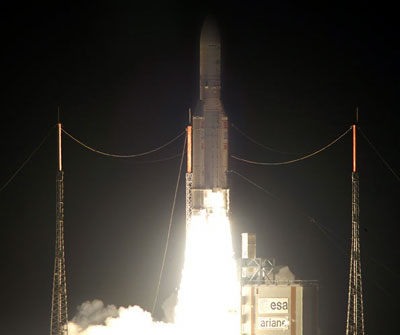Arianespace: super rockets or super sales force?by Taylor Dinerman
|
| It might be useful to compare Arianespace, not to another aerospace company, but to another firm that dominated its market during the 1960 and 1970s: IBM. |
On the other hand, the Europeans should not fool themselves: Ariane is not a success because it is technically superior to its competitors. Getting satellites into orbit is not easy, but it does not require the high degree of what may be termed “elegant engineering” that goes into an Ariane. The Atlas and the Proton launch vehicles get the job done just as effectively.
It might be useful to compare Arianespace, not to another aerospace company, but to another firm that dominated its market during the 1960 and 1970s. IBM did not always have the best technology, but they had the best sales force. After all, back in the 1920s, when they were in the business of making mechanical tabulating machines, they had invented the sales meeting and had refined the business of training and supporting salesmen (there were no saleswomen in those days) to a fine art.
Once it is up and running, a good sales force keep a company going even in the face of serious problems. A dense network of human contacts and a detailed understanding of evolving customer requirements are the main things a good salesperson brings to a business. He or she can share this knowledge and, over time, it becomes a major asset. Arianespace has, it seems, developed such a team, and their effectiveness cannot be underestimated.
Back in the 1960s it was often said, “No one was ever fired for buying IBM.” Today the reliability of Ariane 5, which is roughly comparable to its competitors, combined with the fact that the firm is a stable and well-understood entity, gives the Arianespace sales force some powerful arguments. They are supported by a generous advertising and marketing budget, but without the sales force, these would be just a waste of money.
Like any good CEO, Le Gall knows that nothing lasts forever. Satellite launch vehicle technology is not a fast moving business like computers, but he is more worried about European satellite manufacturers forming alliances with China than he is about low-cost competitors such as SpaceX.
In any case, he wants to make sure that European governments give priority to launching their spacecraft on the Ariane 5 and perhaps on other Arianespace vehicles. A sensible idea from his point of view, but it would seem to clash with the pride he takes in the fact that NASA is going to launch the James Webb Space Telescope on one of his rockets. If Ariane should get priority for European satellites and probes, why should others not play by the same rules, regardless of who pays for the launch?
Early next year ESA’s Automated Transfer Vehicle (ATV) will make its first trip to the International Space Station onboard an Ariane 5. It looks like this will be an annual event giving them yet another secure long-term stream of income. The ATV may be a gold-plated Rolls Royce delivery truck, but building and operating it will teach ESA some extremely valuable lessons that they cannot learn anywhere else.
| What is remarkable about Arianespace is not their relations with the French and other European governments—that is a given in this business—but their commercial success. |
The ATV may—and this is nothing but speculation—be a step towards a fully human-rated launch system based on Ariane 5, the first since the collapse of the French Hermes spaceplane effort in the late 1980s. If ESA does decide to develop a manned launch capability, the ATV gives them a good base on which to build.
What is remarkable about Arianespace is not their relations with the French and other European governments—that is a given in this business—but their commercial success. Year after year no other company has been able to come close to selling as many rides as they do. Over the next decade it will be interesting to watch how they manage to integrate the Soyuz and Vega launch vehicles into their marketing and sales operations. They may find that it is harder to sell a “basket” of products than it is to sell just one.
Arianespace will, without question, remain a formidable competitor for the foreseeable future. They have developed an excellent reputation for service and are working hard to keep it. Any firm that wants to compete against them will have to pay at least as much attention to building its marketing skills and sales force as it does to its hardware. There are no magic bullets: it will take years of hard work, and not a little luck, for anyone to develop the kind of dense network of relationships that seems to give Arianespace its edge.
